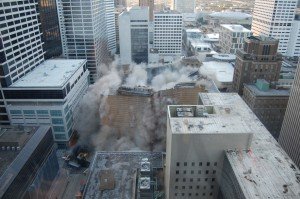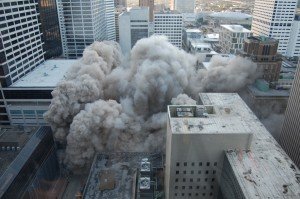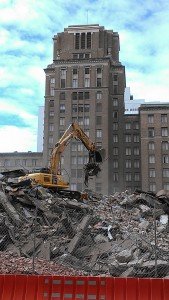On the morning of September 22, 2013, the 1947 art-deco Foley’s (Macy’s since 2006) Building, once known as the most modern department store in the U.S., was reduced to rubble. My office has the fortune to be only two blocks away and positioned perfectly for viewing the implosion. The office held “The End of An Era” Implosion Party on that early Sunday morning.
But more than just convenient shopping, an excellent example of art-deco architecture and local history was lost. Also lost was a tremendous amount of embodied energy.
LEED v4 gives more credit than ever for re-using an existing building, and even more for re-using a historical structure. And that is due largely to the embodied energy that is sequestered in our existing buildings. It is often said that the greenest building is the one that is never built and the second greenest is an existing building. While Indoor Air Quality in some older buildings may be questionable, undoubtedly an existing building is best when it comes to the overall carbon footprint.

A 2012 study done by the National Trust for Historic Preservation titled, “The Greenest Building: Quantifying the Environmental Value of Building Reuse” gives stark evidence of that. Citing the US Department of Energy claim that new construction claims 48% of all material resources consumed in the USA, the report examined several life cycle stages of different building types in four varied climates: Phoenix, Portland, Atlanta and Atlanta. The study assumes that a new building built would last 75 years and use average energy use for that building type.
Using the IMPACT 2002+ Life Cycle Impact Assessment, the results were that it was almost always less harmful to reuse an existing building than build a new one. The only exception was a warehouse to residential conversion because the materials input were so similar to new construction.

Other building types and their corresponding year of “carbon equivalency”:
Mixed Use: 42-80 years
Office: 25-42 years
School: 16-20 years
Preferring the term “Avoided Impact” rather than “Embodied Energy”, the study also revealed that it will take 35-50 years for a new home to recover the carbon expended on construction.
And despite all of this evidence, the Brookings Institute states that we will demolish 27% of all existing buildings within the next 25 years.
To see the full report, go to: www.preservationnation.org/greenlab
The Foley’s Building was the third structure on that block. Originally, large Victorian homes graced it. Next, one of Houston’s best buildings ever stood there for only 16 short years; the 1928 San Jacinto Trust Building. Its entrance was a quick study of Texas history with a mission-style façade topped with a mural of Houston’s history. Sloane Gallery has great photos of it online.
Replacing Foley’s will be the 24-story, 500,000 s.f. Hilcorp Building, slated for opening in 2015. Will it last the 25 to 42 years to offset the carbon lost in that dusty implosion one early Sunday morning? Or will the cycle continue?

